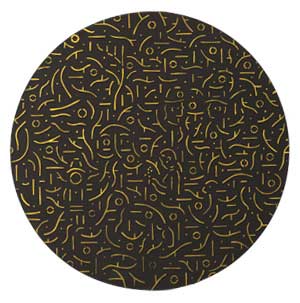

Art Critical Statements
"Deborah Adams Doering's work recalls the work of early and mid-twentieth century organic abstraction, such as the shapes developed by Hans Arp, Piet Mondrian, and seen in the early work of David Smith. Her careful application of paint and ink also relates to her long personal history with the Art Institute of Chicago's masterpiece Georges Seurat's 'A Sunday Afternoon on the Island of La Grande Jatte,' part of a world-class collection. From these and other historical precedents, Doering has constructed her own sturdy conceptual system with which to generate images and compositions, her 'code' of the circle, vertical and horizontal lines, and swashes which represent the circle in motion.
She has successfully taken this 'code' from purely graphic 2-dimensional images, then shifted the symbols to new scales and media, including painting, tapestries, and interactive installation. Her most recent translation ... makes the code dramatically large, literally painted into the landscape, in a sense returning the abstraction back to nature."
Kathryn Hixson, PhD, History of Art
Full Adjunct Professor at the School of the Art Institute of Chicago
Former Editor, New Art Examiner
"Her use of coding and symbols is at once ancient and contemporary, specific and abstract. Ultimately, it is the way in which Doering designs her work to incorporate the natural world which proves most rewarding."
Joseph Becherer
Chief Curator of Collections and Exhibitions Frederik Meijer Gardens and Sculpture Park, Grand Rapids, Michigan
"Deborah Adams Doering's [recent work] has a simple beauty and yet works on several levels. Realizing that the 'codes' that form her work can be viewed in many ways, the interpretation of her art is layered in deep human expression about the meaning of nature in our modern world. She has launched her work onto a new scale from a micro world to a macro world where viewers can immerse themselves in the art, involving them on many levels and experiences ... . One of the most fascinating aspects is that as you are drawn into the art on a bigger level, one can interact with it physically by walking through the 'codes,' viewing them at a distance and from many perspectives up close and far away. This interactive connection to the work gives an exciting new meaning to contemplation of art and conjures many thoughts including 'where do we fit as humans in the world of nature and modern technology.'"
Lea Rosson DeLong, Ph.D, History of Art
Independent Curator, University of Kansas